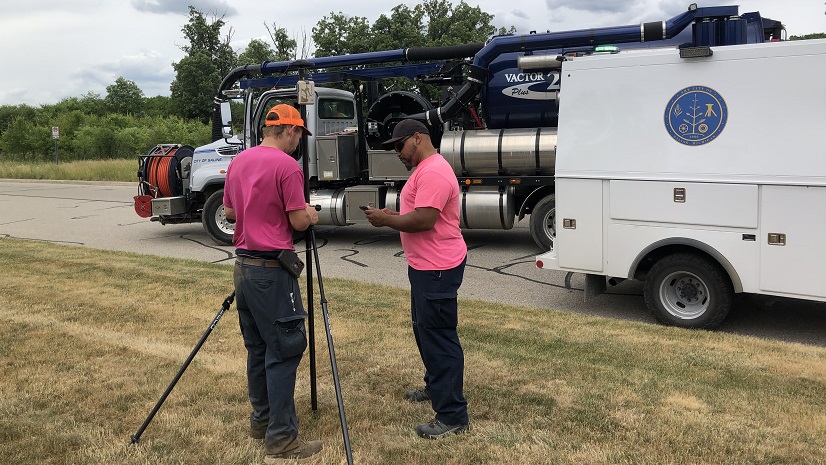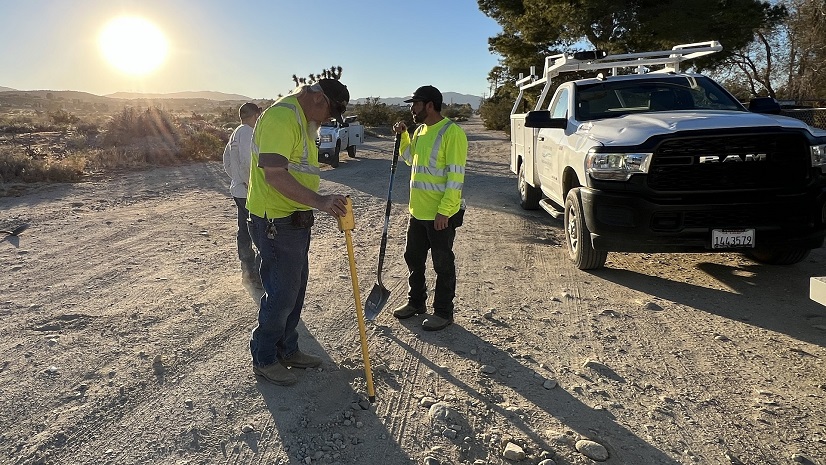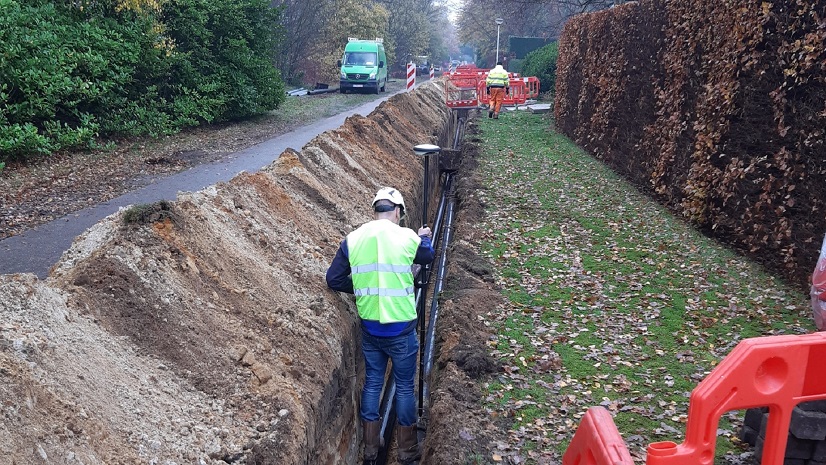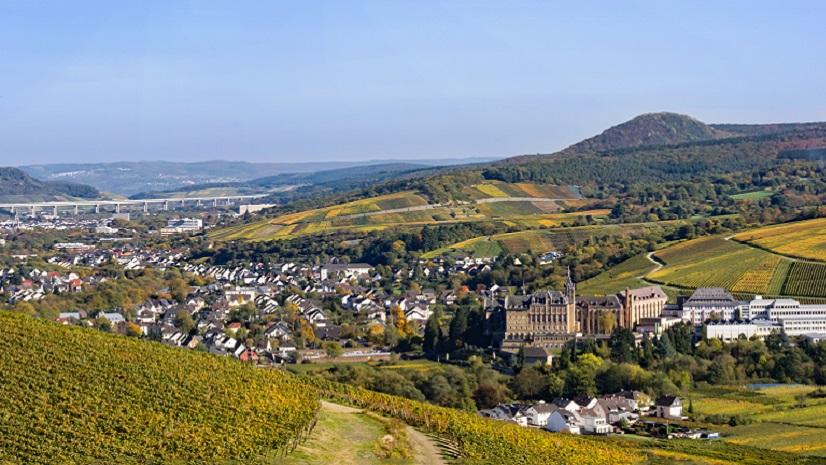By Kimberly Tanz, GIS Analyst and Solution Architect and Justin Kauffman, Director of GIS and Asset Management – Aqua
Introduction
Founded in 1886 in southeastern Pennsylvania, Aqua provides water and wastewater services to over three million people across eight states. While we continue to grow our operations through strategic acquisitions, we have more than 135 years of history and experience maintaining our mission—to protect and provide Earth’s most essential resource.

In the wake of aging infrastructure and climate change, the importance of communicating service disruptions to our customers has never been more apparent. Severe weather impacts our system territories more often now than ever before—heavy storms bring detrimental flooding to our distribution systems, frigid temperatures damage our pipes, and power outages shut down our critical facilities. Customers look to us to keep them adequately informed.
Aqua’s Evolution of Disruption Management
Aqua has a history of tracking disruptions. Originally, we maintained an internal website for our call center, listing known disruptions nonspatially by ZIP code for reference while speaking to customers. Customers could navigate to our public website to find the same list.
In 2021, Aqua’s geographic information system (GIS) department enhanced the process and built our first internally and publicly available Disruption Map apps using Esri’s Web AppBuilder. The original apps allowed customers to search for their address and provided a simple, uniform visual representation of disruptions in their area.

This solution proved useful to our customers, especially during large-scale emergency weather events like the Texas deep freeze and Hurricane Ida in 2021, both of which caused significant disruptions in water service. Over time, however, we gathered feedback internally and from our customers suggesting improvements that could be made. Specifically, flexible symbology, additional feature types, schema additions, and real-time updates.
Providing Tangible Customer Improvements Using ArcGIS Experience Builder
Twenty-first century consumers use smartphones to access information all the time—and as Aqua continued to expand its service areas and customer base, it became apparent our customers did not have an optimized water utility mobile app experience. In 2023, we made a company-wide commitment to make tangible improvements, one of which was to introduce a public-facing ePortal mobile app. The ePortal, announced to launch by January 2024, would allow customers to pay bills, view usage, and identify service disruptions in their area on a map.
The Aqua GIS department used the company ePortal announcement as a catalyst to enhance the existing Disruption Map solution entirely, including the rollout of an updated public map compatible with the ePortal interface.

Building a Foundation for Success
We knew 2023 would be a big year for our GIS department, as we prepared for a major server architecture upgrade alongside a long-term plan to migrate our original apps built with Web AppBuilder to ArcGIS Experience Builder. Esri had announced in February 2023 that Web AppBuilder support would be retired by 2025, so we treated the future Disruption Map solution as a pilot opportunity. This meant we would have to train ourselves in Experience Builder and immediately start developing our Disruption Map solution for a January 2024 launch.
With just 12 months to plan and execute the new Disruption Map solution, we aligned these components of our existing 2023 GIS road map with the ePortal timeline:
- Conducting a complete GIS server architecture review—We worked with our Esri Advantage Program team to better understand our current capacity as well as plan for future traffic on both the internal and public side.
- Upgrading and securing our new server architecture environment—We stood up an environment built to handle over 10,000 concurrent users on the public side, including a secured firewall to feed data from our enterprise environment to ArcGIS Online. Our upgrade comprised more than 20 production and development servers that could adequately accommodate our growing GIS demands internally and externally.
- Gaining Experience Builder knowledge—We took advantage of an Esri on-site instructor-led training course, using it as an opportunity to learn as much as possible about this new interface for web app building. Immediately we took the knowledge from the course and applied it to the Disruption Map solution, knowing that we would eventually do the same for future apps.
Partnering for Possibilities
To ensure that our new solution would be accepted and compatible with the ePortal launch, the GIS department joined a cross-departmental effort to align existing business processes with the overall design of the ePortal. We met with executive leadership, state engineers, operations teams, and customer service representatives, as each of these internal stakeholders served a specific purpose in the disruption reporting and response process. We also engaged with the ePortal design team to understand the proper configurations and compatibility requirements needed on the Esri side.
We operate in eight states with different regulatory requirements and customer needs, so allowing inclusive weigh-in on the Disruption Map solution was critical to achieve company-wide adoption. We used geodesign in practice, building multiple iterations of the solution and adjusting as needed for our internal stakeholders until third quarter when we received the final sign-off to build and implement the solution.
Our Design
By January 2024 we had successfully designed and implemented the new Aqua Disruption Map solution, composed of six apps built using Experience Builder, each serving a specific stakeholder group and purpose.
We played to the strengths of the Experience Builder solution’s flexible configurations and took advantage of our enterprise portal’s ability to limit and manage access levels. Below is a summary of what each app does and whom it serves—this is what worked best for Aqua, but it could be adapted and implemented in any water utility.

One key component of our solution allows customers to view disruptions on a public web app, including no-water and reduced-pressure events, boil-water and system pressure advisories, and even planned work. They can review details about these disruptions and check the app for status updates in real time. By keeping people informed, we build trust and boost customer satisfaction.

Another focal element of our solution is our Disruption Creator—Field app, which was designed for our field staff to quickly and efficiently create or update a disruption event. We leveraged Experience Builder’s Edit widget and Map Viewer forms configurations, which allowed us to pre-fill and mark certain attributes as required, group attributes by header categories, and provide guiding explanations in the create/edit workflow. As a result, it takes our field staff approximately 30 seconds to create a disruption event, allowing them ample time to focus on other critical tasks during a disruption event like making repairs and restoring service to our customers.

Implementation and Change Management
Building a new solution is a challenge in itself—and rolling it out across eight states to two call centers and our customer base is another. Many of our users either were accustomed to the first release of the solution or had never gotten the proper exposure to it in the first place to use it to their advantage.
By introducing this release, the GIS department was also accountable for communicating executive-driven, company-wide operational changes in which:
- Field employees would now be responsible for creating and editing no-water and low-pressure disruption events.
- Operations employees would now be creating and editing advisories by means of drawing polygon boundaries around affected customers.
- Call center representatives would now be required to use their map while assisting customers.
- Customers would now be able to log in to the ePortal app to review usage, pay bills, and view disruptions on their own map.
Our change management strategy largely required communicating across the company hierarchy, conducting both virtual and in-person training sessions, and creating training materials for internal users. We made sure the following channels were covered:

Our dedication to change management was a requirement for a successful implementation strategy, and it continues to be something we work toward fine-tuning for future GIS application releases.
Our solution keeps evolving with user feedback. Aqua is using the disruptions tracked by the applications to understand where our customers are experiencing reduced levels of service and to help guide our infrastructure investments. The specific results provided below are measures that help us understand the use and success of the solution. Our operations teams have told us that customers like the public map and appreciate our dedication to keep them informed while service is being restored.

Increased Visibility
- Customers using the Disruption Map are informed and updated in real time, which reduces call center volume.
- Company-wide transparency regarding service disruptions helps us run more efficiently and reduces duplicate work orders being sent to our field crews.
- Capital improvement dollars can be prioritized in areas experiencing greater disruption volume.
Cost Savings
- We used our existing Esri licensing and leveraged Experience Builder at no extra cost.
- We chose configuration over customization. Using off-the-shelf Esri tools has a lower cost in the long term for maintenance, upkeep, and any additional changes that need to be implemented over time.
- We can reduce unplanned maintenance costs using insights from historic disruption events that signal areas where maintenance is needed.
Long-Term Partnerships
- Working cross-departmentally helped us gather the insight needed to build the best solution.
- Our change management strategy allowed us to build trust and ongoing relationships with our solution stakeholders, providing a foundation for implementing future GIS projects.
- Our willingness to work with other departments on this solution paved the way for us to act as trusted stakeholders in non-GIS projects at Aqua.
Stay Connected with Esri’s Water Team
ArcGIS is an extensive information system that enables modernization of workflows with easy-to-use applications for the field and office. Strengthen your organization with smart water solutions that will increase efficiency and provide insight for decision-makers. Visit the Esri Water Utilities web site for more information.
Join the Water Utilities Community
Follow #EsriWater on social media: X | LinkedIn
Subscribe to the Water Industry newsletter “Esri News for Water Utilities and Water Resources“






